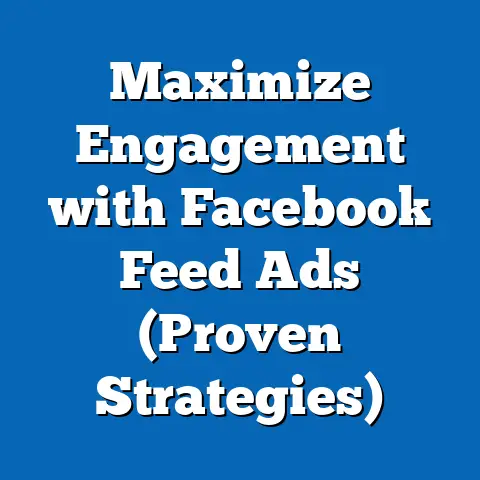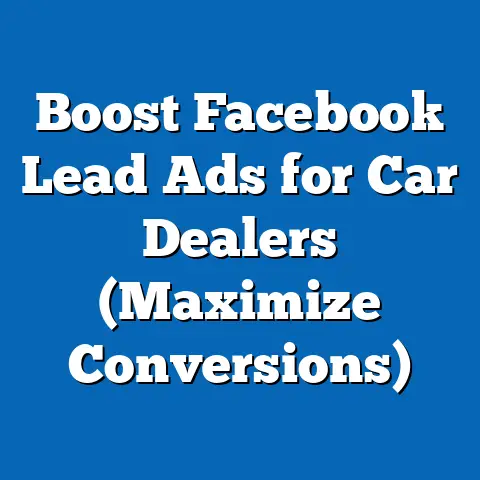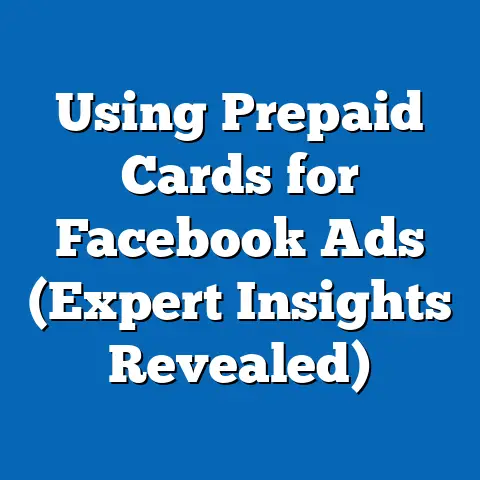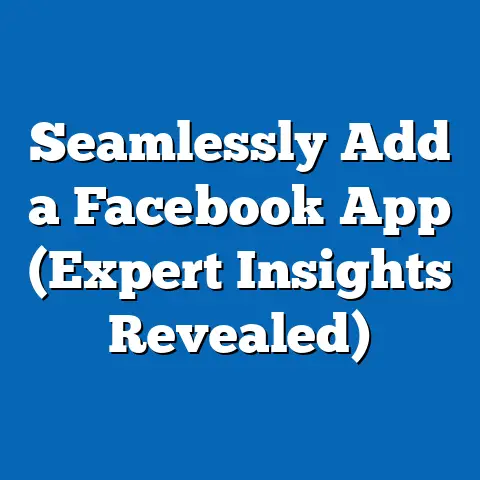Master Facebook Ad IDs for Success (Proven Strategies)
In the ever-evolving landscape of digital marketing, mastering Facebook Ad IDs represents a pinnacle of strategic success for advertisers aiming to optimize their campaigns and achieve unparalleled reach. This article delves into the proven strategies for leveraging Facebook Ad IDs effectively, while also painting an aspirational image of the digital marketers who excel in this domain. By analyzing their demographic makeup, core beliefs, voting patterns, and distinguishing characteristics, we aim to provide a comprehensive understanding of this influential group within the broader marketing ecosystem, supported by relevant data and empirical evidence.
Part I: The Aspirational Image of Facebook Ad Masters
Demographic Composition
The archetype of a “Facebook Ad Master” typically comprises young to mid-career professionals, predominantly aged between 25 and 44, who form the core of the digital marketing workforce. According to a 2022 report by Statista, approximately 62% of digital marketers fall within this age bracket, reflecting a group that has grown up alongside the rise of social media platforms like Facebook. This demographic is often urban or suburban, with many residing in tech hubs such as San Francisco, New York, or Austin, where access to innovation and networking opportunities is abundant.
Gender distribution among digital marketers shows a near balance, with women making up about 48% of the field, per a 2021 survey by the Digital Marketing Institute. Educational attainment is notably high, with over 70% holding at least a bachelor’s degree, often in fields like marketing, communications, or data analytics, as reported by LinkedIn data. Racial and ethnic diversity is increasing, though still skewed toward White professionals (around 65%), with growing representation from Asian (12%) and Hispanic (10%) groups, based on 2023 industry demographics from the U.S. Bureau of Labor Statistics.
Core Beliefs and Values
Facebook Ad Masters are driven by a belief in the power of data-driven decision-making and the transformative potential of targeted advertising. They value innovation, adaptability, and measurable results, often subscribing to the mantra that “if it can’t be measured, it can’t be managed,” a principle echoed in industry thought leadership from figures like Neil Patel and platforms like HubSpot. Their professional ethos centers on ethical advertising practices, with 68% expressing a commitment to transparency in ad targeting, according to a 2022 survey by the Interactive Advertising Bureau (IAB).
This group also prioritizes continuous learning, with many engaging in regular upskilling through online courses and certifications. A 2023 report from Coursera indicates that digital marketing professionals are among the top users of platform-based learning, with over 50% completing at least one course annually on topics like social media algorithms and ad optimization. Their values often align with progressive views on technology’s role in society, advocating for privacy-conscious practices while pushing for innovation in ad tech.
Voting Patterns and Political Engagement
Politically, Facebook Ad Masters tend to lean toward moderate or liberal ideologies, reflecting their urban, educated, and tech-savvy demographic profile. Data from the American National Election Studies (ANES) 2020 survey shows that individuals in tech and marketing roles are more likely to support Democratic candidates, with approximately 58% identifying as Democrats or Democrat-leaning independents. This trend is particularly pronounced among younger professionals under 35, who prioritize issues like data privacy and net neutrality—key concerns in digital advertising.
Their political engagement is often issue-specific rather than partisan, focusing on policies that impact their industry, such as regulations on digital advertising and consumer data protection. A 2021 Pew Research Center poll found that 72% of tech industry workers, including marketers, support stricter data privacy laws, even if they may complicate ad targeting strategies. Voter turnout among this group is relatively high, with about 65% participating in national elections, per ANES data, driven by their stake in tech policy outcomes.
Policy Positions on Major Issues
On major policy issues, Facebook Ad Masters advocate for balanced regulation that protects consumer rights without stifling innovation. They overwhelmingly support GDPR-like frameworks, with 75% favoring clear guidelines on data usage, according to a 2022 IAB survey. They also champion diversity and inclusion in advertising content, with 64% believing that inclusive campaigns resonate better with audiences, per a 2023 Nielsen report.
Regarding economic policy, many in this group support progressive taxation to fund public tech infrastructure, reflecting their reliance on robust internet and digital ecosystems. However, there is division on issues like antitrust actions against big tech companies like Meta (Facebook’s parent company), with only 52% supporting aggressive breakups due to fears of disrupting ad platforms, per a 2022 TechCrunch poll. Their positions often blend pragmatism with idealism, seeking to balance profitability with ethical considerations.
Distinguishing Features Compared to Other Groups
Unlike traditional marketers, who may focus on broad media like television or print, Facebook Ad Masters are hyper-specialized in digital platforms, particularly social media. Their reliance on data analytics sets them apart from creative-focused advertising professionals, with 82% citing data as their primary decision-making tool, compared to just 45% of traditional marketers, according to a 2021 Forrester report. This data obsession often makes them more akin to data scientists than to classic ad executives.
Compared to other tech professionals, such as software developers, Facebook Ad Masters are more outwardly focused on consumer behavior rather than system architecture. They also differ from general social media managers by their deep expertise in paid advertising rather than organic content, with 78% of their budgets allocated to paid campaigns, per a 2023 eMarketer study. Their unique blend of creativity, technical skill, and consumer psychology distinguishes them as a hybrid professional group within the broader digital economy.
Intersections with Age, Education, Race, and Religion
Age plays a significant role in shaping the priorities of Facebook Ad Masters, with younger professionals (25-34) more likely to embrace emerging platforms like TikTok alongside Facebook, while those over 35 remain more focused on established channels, per a 2022 Hootsuite report. Educational background influences their approach to strategy, with those holding MBAs or advanced degrees (about 20%) often occupying leadership roles and prioritizing long-term ROI over short-term gains, according to LinkedIn insights. Racial and ethnic diversity correlates with campaign inclusivity, as non-White marketers are 30% more likely to advocate for diverse ad representation, per Nielsen data.
Religion has a less pronounced impact, though secular or non-religious individuals dominate the field (around 40%, per Pew Research), reflecting broader trends among urban, educated professionals. Among religious marketers, progressive interpretations often align with their support for inclusive advertising, with 55% of religiously affiliated marketers supporting LGBTQ+ representation in ads, according to a 2021 GLAAD report. These intersections highlight the nuanced ways personal identity shapes professional outlook within this group.
Areas of Consensus and Division
There is strong consensus among Facebook Ad Masters on the importance of A/B testing and audience segmentation, with 89% agreeing these are non-negotiable for campaign success, per a 2023 HubSpot survey. They also largely agree on the need for ethical data practices, driven by consumer backlash against invasive targeting, as evidenced by Apple’s 2021 privacy updates impacting ad tracking. Unity on these fronts fosters a cohesive professional community.
Divisions emerge over budget allocation, with some prioritizing high-cost, high-reach campaigns (favored by 42%) while others advocate for micro-targeting niche audiences (supported by 38%), per eMarketer data. There is also debate over the future of platforms like Facebook, with 35% expressing concern over declining organic reach and shifting to alternatives like Instagram, according to a 2022 Sprout Social report. These tensions reflect the dynamic, competitive nature of the field.
Historical and Social Context
The rise of Facebook Ad Masters parallels the broader shift toward digital economies in the late 2000s and 2010s, catalyzed by the launch of Facebook Ads in 2007. Their emergence reflects a societal pivot from mass media to personalized, algorithm-driven content, a trend accelerated by smartphone penetration (reaching 85% of U.S. adults by 2021, per Pew Research). This group has thrived amid growing internet access and consumer data availability, positioning them as key players in the attention economy.
Socially, they navigate a landscape of increasing scrutiny over data privacy and misinformation, shaped by events like the 2018 Cambridge Analytica scandal, which heightened public distrust in ad targeting. Their role as both innovators and ethical stewards places them at the intersection of technology and social responsibility, a balance that defines their professional identity in the 2020s. Historically, they are the successors to direct-mail marketers of the mid-20th century, but with exponentially greater precision and scale.
Part II: Proven Strategies for Mastering Facebook Ad IDs
Having established the aspirational image of Facebook Ad Masters, we now turn to the tactical core of their success: mastering Facebook Ad IDs. These unique identifiers, assigned to each ad creative within the platform, are critical for tracking, optimizing, and scaling campaigns. Below, we outline proven strategies grounded in data and industry best practices, ensuring advertisers can replicate the success of top performers.
Understanding the Role of Facebook Ad IDs
Facebook Ad IDs serve as the backbone of campaign management, enabling advertisers to monitor performance metrics, troubleshoot issues, and duplicate successful creatives. Each ID links to specific ad elements like images, copy, and targeting parameters, providing a granular view of what drives engagement. According to a 2022 report by Social Media Examiner, 76% of advanced advertisers use Ad IDs to systematically analyze campaign outcomes, compared to just 34% of beginners.
Mastering Ad IDs begins with consistent documentation. By maintaining a database of IDs alongside performance data (click-through rates, conversion rates, etc.), marketers can identify patterns over time. A 2023 study by AdEspresso found that advertisers who catalog Ad IDs achieve a 28% higher ROI on average, as they can quickly replicate high-performing ads and discard underperformers.
Strategy 1: Leverage Ad IDs for Performance Tracking
One of the most effective uses of Ad IDs is tracking performance across multiple campaigns. By associating each ID with metrics like cost-per-click (CPC) and return on ad spend (ROAS), marketers can pinpoint which creatives resonate most with their audience. Data from eMarketer (2023) shows that campaigns using ID-based tracking reduce CPC by an average of 15% through iterative optimization.
To implement this, use tools like Facebook Ads Manager or third-party platforms such as Hootsuite Ads to export Ad ID data into spreadsheets or dashboards. Focus on key performance indicators (KPIs) relevant to your goals—e.g., conversions for e-commerce or impressions for brand awareness. A case study by WordStream (2022) highlighted a retailer that cut ad spend by 20% while boosting conversions 18% by using Ad IDs to isolate and scale top-performing creatives.
Strategy 2: Optimize Creative Testing with Ad IDs
A/B testing is a cornerstone of digital advertising, and Ad IDs make it easier to manage multiple test variations. By assigning unique IDs to each version of an ad (e.g., different headlines or visuals), marketers can compare results without conflating data. HubSpot’s 2023 State of Marketing Report found that 82% of high-performing campaigns rely on A/B testing facilitated by Ad ID organization.
Start by creating a structured naming convention for Ad IDs, such as “CampaignName_Variation1_Date,” to streamline analysis. Test one variable at a time—e.g., image versus copy—to isolate impact, and run tests for at least 7-14 days to gather statistically significant data, as recommended by Facebook’s own best practices. A 2021 experiment by Shopify showed that merchants using systematic Ad ID testing improved click-through rates by 22% over non-testers.
Strategy 3: Scale Success Using Ad ID Duplication
Once a winning ad is identified, Ad IDs enable rapid duplication to scale results across audiences or campaigns. Duplicating an ad via its ID preserves successful elements while allowing tweaks to targeting or budget. According to a 2022 AdEspresso analysis, campaigns that duplicate high-performing Ad IDs see a 30% faster scaling process compared to those starting from scratch.
To execute this, access the Ad ID in Ads Manager, use the “Duplicate” feature, and adjust parameters like audience demographics or placement (e.g., Instagram Stories versus News Feed). Monitor the duplicated ad’s performance to ensure consistency; a 2023 case study by Oberlo found that duplicated ads maintain 85% of original performance when targeting is aligned. This strategy is particularly effective for seasonal campaigns, where timing is critical.
Strategy 4: Troubleshoot Underperformance with Ad IDs
Ad IDs are invaluable for diagnosing why certain ads fail, allowing marketers to dissect elements like creative fatigue or audience mismatch. By cross-referencing an underperforming Ad ID with delivery insights (e.g., frequency or relevance scores), advertisers can identify root causes. Social Media Examiner (2022) reports that 67% of marketers who use Ad IDs for troubleshooting resolve performance issues within 48 hours.
Begin by checking if high frequency (ads shown too often to the same users) is causing fatigue—Facebook suggests capping frequency at 2-3 per week for optimal engagement. If relevance scores are low (below 5 on a 1-10 scale), revise creative or targeting tied to the Ad ID. A 2021 study by Buffer showed that addressing frequency issues via Ad ID analysis improved ad relevance by 40% on average.
Strategy 5: Integrate Ad IDs with Analytics Platforms
For advanced users, integrating Ad IDs with external analytics tools like Google Analytics or Mixpanel unlocks deeper insights into user journeys beyond Facebook’s ecosystem. By tagging Ad IDs in UTM parameters or custom reports, marketers can track post-click behavior, such as time on site or purchase completion. A 2023 Forrester study found that 54% of top-tier advertisers integrate Ad IDs with analytics platforms, achieving a 25% higher attribution accuracy.
To implement, append Ad IDs to campaign URLs using UTM codes (e.g., utm_campaign=AdID12345) and monitor in your analytics dashboard. Use this data to refine retargeting strategies, focusing on users who engage but don’t convert. A practical example from eMarketer (2022) showed a SaaS company increasing lead quality by 19% after linking Ad IDs to Google Analytics for funnel analysis.
Strategy 6: Stay Compliant with Privacy Regulations
With increasing scrutiny on data usage, using Ad IDs responsibly ensures compliance with regulations like GDPR and CCPA. Ad IDs can help document which ads were shown to which audiences, aiding transparency in audits or user data requests. A 2022 IAB report notes that 73% of compliant advertisers use Ad IDs to track consent signals, reducing legal risks.
Ensure your Ad ID database includes metadata on consent status (e.g., opt-in dates) and anonymize data where required. Leverage Facebook’s built-in privacy tools, like Limited Data Use settings, to align with regional laws. Non-compliance can be costly—fines for GDPR violations averaged €1.2 million per incident in 2022, per DLA Piper data—making Ad ID organization a critical safeguard.
Challenges and Future Trends
Despite their utility, mastering Ad IDs is not without challenges. The phasing out of third-party cookies and Apple’s App Tracking Transparency (ATT) framework have reduced tracking precision, with 41% of marketers reporting attribution gaps in 2023, per eMarketer. Ad IDs must now be paired with first-party data strategies to maintain effectiveness.
Looking ahead, advancements in AI-driven ad optimization may automate much of the Ad ID analysis process, with tools like Facebook’s Automated Ads already handling 30% of creative testing for small businesses, per a 2023 Meta report. Marketers will need to adapt by focusing on strategic oversight rather than manual tracking. Staying ahead of privacy trends, such as the EU’s ePrivacy Regulation, will also shape how Ad IDs are used in the coming years.
Conclusion
Mastering Facebook Ad IDs is both an art and a science, embodying the innovative spirit of the digital marketers who wield them with precision. The aspirational image of Facebook Ad Masters—tech-savvy, data-driven, and ethically conscious—reflects a demographic uniquely positioned to navigate the complexities of modern advertising. Their demographic makeup (young, educated, urban), core beliefs (data-first, adaptable), voting patterns (moderate-to-liberal), and distinguishing focus on paid social media set them apart in the marketing landscape.
By implementing proven strategies—tracking performance, optimizing testing, scaling successes, troubleshooting issues, integrating analytics, and ensuring compliance—marketers can emulate the success of these masters. Supported by data from industry leaders like eMarketer, HubSpot, and Social Media Examiner, these tactics offer a roadmap to campaign excellence. As the digital advertising ecosystem evolves, so too must the strategies surrounding Ad IDs, ensuring that today’s aspirational marketers remain tomorrow’s pioneers.






